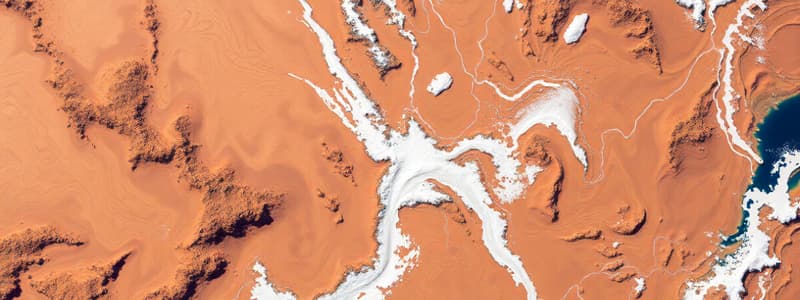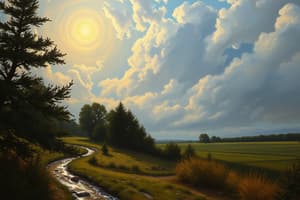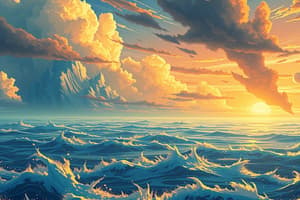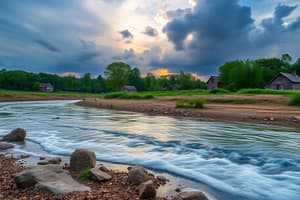Podcast
Questions and Answers
Which of the following is NOT a factor that influences climate?
Which of the following is NOT a factor that influences climate?
- Distance from the ocean
- Latitude
- Altitude
- Population density (correct)
The leeward side of a mountain is typically drier than the windward side.
The leeward side of a mountain is typically drier than the windward side.
True (A)
What is the name of the instrument used to measure air pressure?
What is the name of the instrument used to measure air pressure?
Barometer
The amount of water vapor in the air is called ______.
The amount of water vapor in the air is called ______.
Match the following terms with their respective definitions:
Match the following terms with their respective definitions:
Which of these gases are responsible for the greenhouse effect and contribute to global warming? (Select all that apply)
Which of these gases are responsible for the greenhouse effect and contribute to global warming? (Select all that apply)
Deforestation contributes to climate change by absorbing carbon dioxide from the atmosphere.
Deforestation contributes to climate change by absorbing carbon dioxide from the atmosphere.
What is the primary cause of global warming?
What is the primary cause of global warming?
The ______ of a star is a measure of its apparent brightness as seen from Earth.
The ______ of a star is a measure of its apparent brightness as seen from Earth.
Match the following terms to their corresponding volcanic features:
Match the following terms to their corresponding volcanic features:
Which type of volcanic eruption is characterized by violent explosions and the release of ash and pyroclastic flows?
Which type of volcanic eruption is characterized by violent explosions and the release of ash and pyroclastic flows?
What type of volcano is formed by the accumulation of flowing lava, creating a broad, shield-like structure?
What type of volcano is formed by the accumulation of flowing lava, creating a broad, shield-like structure?
The color of a star directly indicates its size.
The color of a star directly indicates its size.
Flashcards
Weather
Weather
The condition of the atmosphere at a specific place and time.
Temperature
Temperature
The degrees of hotness or coldness of a place.
Humidity
Humidity
The amount of water vapor in the air.
Climate
Climate
Signup and view all the flashcards
Latitude
Latitude
Signup and view all the flashcards
Rain Shadow
Rain Shadow
Signup and view all the flashcards
Global Warming
Global Warming
Signup and view all the flashcards
Greenhouse Effect
Greenhouse Effect
Signup and view all the flashcards
Greenhouse Gases
Greenhouse Gases
Signup and view all the flashcards
Fossil Fuels
Fossil Fuels
Signup and view all the flashcards
Deforestation
Deforestation
Signup and view all the flashcards
Effects of Climate Change
Effects of Climate Change
Signup and view all the flashcards
Shield Volcano
Shield Volcano
Signup and view all the flashcards
Cinder Cone Volcano
Cinder Cone Volcano
Signup and view all the flashcards
Plinian Eruption
Plinian Eruption
Signup and view all the flashcards
Renewable Energy
Renewable Energy
Signup and view all the flashcards
Study Notes
Weather and Climate
- Weather is the condition of the atmosphere at a specific time and place.
- Temperature is the measure of hotness or coldness.
- Wind is the movement of air.
- Air pressure is the force caused by the weight of air.
- Humidity is the amount of water vapor in the air.
- Precipitation is water falling from the atmosphere (rain, snow, hail).
- Climate is the general pattern of weather over a long time.
- Latitude is the distance north or south of the equator.
- Tropical zone is near the equator.
- Temperate zone is in the middle latitudes.
- Polar zone is at high latitudes.
- Altitude is the height above sea level. Temperature decreases with increasing altitude.
Topography and Landforms
- Leeward side is the side of a mountain where wind flows down.
- Windward side is the side of a mountain facing the wind.
- Rain shadow is a dry region on the leeward side of a mountain.
- Topography is the study of the shape of the land surface.
Oceans and Bodies of Water
- Ocean is a large expanse of sea.
- Bodies of water are parts of Earth's surface covered by water.
- Coastal areas have lower temperatures compared to inland areas far from the sea.
- Ocean currents bring cold water.
Stars
- Stars are massive, glowing balls of gas that produce their own light and heat.
- Stars can be different colors (blue, red, yellow, orange), with the blue being hottest.
Volcanoes
- Volcanoes are openings in the Earth's surface from which molten rock, smoke, gases, and ashes are ejected.
- Crater is a funnel-shaped depression at the top of a volcano, formed by explosive eruptions.
- Caldera is a large crater formed by the collapse of the volcano's structure.
- Magma is molten rock inside the Earth.
- Lava is magma that has been ejected.
- Shield volcanoes are formed by the accumulation of non-viscous lava flows.
- Cinder cone volcanoes have steep slopes and are built from ejected fragments.
- Composite volcanoes (stratovolcanoes) are large, nearly perfect slopes formed by the alternation of lava and pyroclastic (ash) deposits.
- Phreatic eruptions are steam-driven, caused by contact between magma and water.
- Phreatomagmatic eruptions are violent, caused by the interaction of water and magma.
- Strombolian eruptions are characterized by fountain lava.
- Vulcanian eruptions are characterized by tall eruptions with pyroclastic flows and tephra.
- Plinian eruptions are extremely explosive, releasing gas and pyroclastics.
Global Warming and Climate Change
- Climate change is a natural phenomenon of changes in average weather of a given area or region.
- Global warming is a change in the Earth's temperature.
- Greenhouse effect is the process by which radiation from the sun is absorbed by greenhouse gases and not reflected back into space.
- Gases responsible for the existence of life on Earth include carbon dioxide, nitrous oxide, methane, and water vapor. Several human activities, such as burning fossil fuels, intensive farming, and livestock raising, exacerbate global warming.
Studying That Suits You
Use AI to generate personalized quizzes and flashcards to suit your learning preferences.




